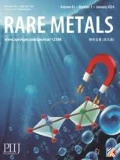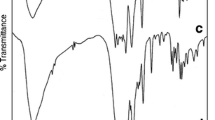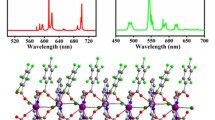Abstract
A series of rare earth complexes Tb1−x Eu x (MAA)3phen (x=0.00, 0.01, 0.03, 0.05, 0.07, 0.09, 0.10, 0.30, and 0.50) were synthesized with MAA as the first ligand and phen as the second ligand. The complexes were characterized by means of FT-IR, thermogravimetry-differential scanning calorimetry (TG-DSC), XRD, UV absorption spectra, and photoluminescence spectra (PL). The results show that the luminescence intensity of Eu3+ increases as Tb3+ transfer the absorbed energy to Eu3+ in the complexes. The emission of Tb3+ at 545 nm is observed and increasing with x decreasing. When x=0.01, the luminescence intensity reaches the maximum value, and the emission intensity of Tb3+ at 545 nm and Eu3+ at 614 nm are almost equal. It realizes the co-luminescence of Eu3+ and Tb3+. We can obtain complexes with different colors by adjusting the ratio of Eu3+ to Tb3+.
Similar content being viewed by others
References
Liu X., Gao S., Wang L., Shen L., Jiang J., and Gao J., Synthesis, luminescent properties, and theoretical study of novel Sm3+ and Dy3+ complexes containing β-diketone and 1,10-phenanthroline, Rare Met., 2011, 30(1): 28.
Yatabe T., Nakai H., Nozaki K., Yamamura T., and Isobe K., Photofunctionalization of a pentamethylcyclopentadienyl ligand with the N-phenylcarbazolyl group to prepare a highly luminescent Tb3+ complex having a fast radiation rate, Organometallics, 2010, 29(11): 2390.
Mooibroek T.J., Gamez P., Pevec A., Kasunic M., Kozlevcar B., Fu W. T., and Reedijk J., Efficient, stable, tunable, and easy to synthesize, handle and recycle luminescent materials: H2NMe2 (3) Ln(III)(2,6-dipicolinolate)(3) (Ln=Eu, Tb, or its solid solutions), Dalton Trans., 2010, 39(28): 6483.
Zhao X., Huang K., Jiao F., Li Z., and Peng X., Fluorescence enhancement and cofluorescence in complexes of terbium(III) with trimellitic acid, Rare Met., 2006, 25(2): 144.
Shukla P., Sudarsan V., Vatsa R. K., Nayak S. K., and Chattopadhyay S., Effect of symmetric substitution on the phenyl groups of Eu3+-dibenzoyl methane complexes on their luminescence properties, J. Lumin., 2010, 130(10): 1952.
Raj D. B. A., Francis B., Reddy M. L. P., Butorac R. R., Lynch V. M. and Cowley A. H., Highly luminescent poly (methyl methacrylate)-Incorporated europium complex supported by a carbazole-based fluorinated β-diketonate ligand and a 4,5-bis(diphenylphosphino)-9,9-dimethylxanthene oxide co-ligand, Inorg. Chem., 2010, 49(19): 9055.
Li B., Chen Q.-Y., Wang Y.-C., Huang J., and Li Y., Synthesis, characterization and fluorescence studies of a novel europium complex based sensor, J. Lumin., 2010, 130(12): 2413.
Fu Y., Zhang J., Huang Z., Wang X., Lv Y., and Cao W., Study of the effect of ligands on the fluorescence properties of terbium ternary complexes, J. Photochem. Photobiol. A: Chem., 2008, 197(2–3): 329.
Lv L.G., Zhang J.C., Cao W.L., Yuan K., Zhang F.J., and Xu Z., Synthesis and characterization of binuclear complexes Tb1−x Eux( TTA)3 Phen, J. Chin. Soc. Rare Earths, 2006, 24(06): 649.
Kerbellec N., Kustaryono D., Haquin V., Etienne M., Daiguebonne C., and Guillou O., An unprecedented family of lanthanide-containing coordination polymers with highly tunable emission properties, Inorg. Chem., 2009, 48(7): 2837.
de Lill D.T., de Bettencourt-Dias A., and Cahill C.L., Exploring lanthanide luminescence in metal-organic frameworks: synthesis, structure, and guest-sensitized luminescence of a mixed europium/terbium-adipate framework and a terbium-adipateframework, Inorg. Chem., 2007, 46(10): 3960.
Hilder M., Junk P. C., Kynast U. H. and Lezhnina M. M., Spectroscopic properties of lanthanoid benzene carboxylates in the solid state: Part 1, J. Photochem. Photobiol. A: Chem., 2009, 202(1): 10.
Chai W., Li W., Sun X., Ren T., and Shi X., Fluorescence enhancement of lanthanide(III) perchlorate by 1,10-phenanthroline in bis(benzoylmethyl) sulfoxide complexes and luminescence mechanism, J. Lumin., 2011, 131(2): 225.
Quirino W.G., Legnani C., Cremona M., Lima P.P., Junior S. A., and Malta O. L., White OLED using β-diketones rare earth binuclear complex as emitting layer, Thin Solid Films, 2006, 494(1–2): 23.
Susumu Sato M.W., Relations between intr-amolecular energy transfer efficiencies and triplet state inrare earth β-diketone chelates, Bull. Chem. Soc. Jpn., 1970, 43(7): 1955.
Author information
Authors and Affiliations
Corresponding author
Rights and permissions
About this article
Cite this article
Chen, Y., Zhang, J., Zhang, L. et al. Synthesis and co-luminescence properties of Tb3+-methacrylic acid-1,10-phenanthroline complexes doped with Eu3+ . Rare Metals 31, 479–483 (2012). https://doi.org/10.1007/s12598-012-0543-2
Received:
Revised:
Accepted:
Published:
Issue Date:
DOI: https://doi.org/10.1007/s12598-012-0543-2




